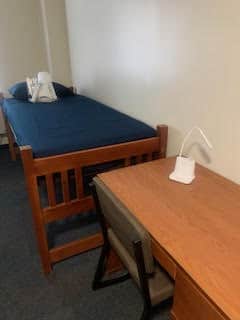Two community colleges in cities with very high housing costs have found a way to provide housing for homeless students.
Among the lessons they learned is that providing housing is only a start for traumatized students who have been homeless, many of them formerly incarcerated. But for Cerritos College in Los Angeles County and the Borough of Manhattan Community College, which is part of the City University of New York system, it’s a big help for the students involved.
Working with local nonprofit
At Cerritos College, working with funders and strategic partners that provide services has been a big part of the program’s success. In 2018, a Hope Lab survey of California community college students found that 55% of the college’s students were housing insecure, and of those, 15% were homeless.
With support from the college’s board of trustees, Cerritos looked at how it could house the students, said President Jose Fierro. He got in touch with a community member who was a real estate developer.
“We bought the land, built seven townhomes there, and created a lease agreement with Jovenes,” Fierro said. (Jovenes Inc. is a Los Angeles-based nonprofit that offers support services for homeless youths.) “We were able to leverage district resources, county resources and grants.”
“We own everything outright,” Fierro added.
The college has received some funding from the state and the local board of supervisors and spends a little more than $700,000 annually on the facilities.
“The success of this operation is because we allowed our partners to contribute their expertise,” Fierro said. “Jovenes is very good at providing housing and rehousing for those students who are struggling. Mental health services come from other resources. We all bring something to the table. The cost is lower because we don’t have overlap,” Fierro said.
More than just homes
Seven townhomes, known as The Village, have housed students since May 2020. Staff and security officers are always on site. With one house set aside for administration purposes, the other six buildings can house up to 26 students.
Students can refer themselves through a website, and many apply.
“We’re constantly screening to assess students,” said Eric Hubbard, director of development and strategic partnerships at Jovenes. “It’s not for students who don’t want to pay rent. It’s for students experiencing homelessness. They go through a verification process.”
Once they meet the basic qualifications, it’s first come, first served.

Jovenes is partnering with the college to provide other options such as rental subsidies to students, especially those with kids. The program also offers affordable housing for $195 to $380 a month and a more short-term motel support program. Jovenes is connected to Los Angeles’ larger homeless services system and can make referrals to that, Hubbard said.
All the residents at The Village are ages 18 to 24. Some students may have children, but the children don’t live there. There’s another housing program for single parents.
There’s no time limit for how long students can stay at The Village, said Hubbard, other than when they graduate. If a student drops out of school or isn’t meeting the required academic standards, they must leave.
“We go over budget all the time for emergency assistance – everything from groceries to phone bills to furniture,” Hubbard said. “Part of it is being a financial counselor to students.”
Another part is mental health services.
“If you’re homeless, you’re experiencing trauma. A lot of our work is helping them recover from trauma,” Hubbard said. “Seeing a student who’s been experiencing homelessness achieving their goals – knowing the housing we’ve been able to provide played a small part in that – it’s very rewarding.”
Making an impact
The program has made a big difference in students’ academic success, said Fierro, the college’s president. More than 40% of students living in The Village graduated in the first two years, including 25% of Latino students.
“Students are responding well as we help them meet those basic needs,” Fierro said.
Looking to expand the program, the college has applied to the state chancellor’s office to build 396 beds on campus.
Teaming with a local church
As Cerritos College was working with a nonprofit, across the country Borough of Manhattan Community College (BMCC) started a partnership with a neighboring church with a philanthropy program. Trinity Church Wall Street had recently started to focus its philanthropy work more on organizations in its own neighborhood, said Tasha Tucker, senior program director for racial justice at the church.
“BMCC seemed like a natural,” Tucker said. “It had a great many low-income students of color.”
Trinity helped BMCC host a 2019 conference on assisting formerly incarcerated students advance their education. The conference led to the creation of Project Impact, which offered these students peer mentors who connected them with academic and social services.
When Trinity learned that many BMCC students were homeless or housing insecure, the church created a $2 million startup grant for housing services. Those funds provided housing for 40 students and also created an emergency fund to hire one full-time and one part-time support staff, said Marva Craig, BMCC vice president of student affairs. The first students moved in earlier this year.
Adapting to dorm life
The housing consists of apartment-style dorms with two beds in each bedroom. A residential life manager and residential assistant live onsite with the students, ensuring that residents have what they need, helping them resolve conflicts and creating group activities. The staff ensures that the students meet the criteria to live in the dorms, which means being enrolled for at least nine credits.

“Most have never lived in a dorm before,” Craig said. “So we know we have a lot of managing to do.”
One challenge has been recognizing that the students are not traditional college-age learners, Craig said.
“We’re not talking to kids, [saying], ‘What would your parents say?’ They are the parents,” she said.
The staff asks students to make an agreement among the four residents of each apartment dorm, covering questions like cleaning and visitors.
“How long can a visitor stay?” Craig said. “It’s a lot to bring other people into this space. Sometimes they stay a little longer because they have no place to go.”
A lifeline
The housing has been a lifeline for the students who live there.
“I’ve heard stories from students – they were couch surfing or in shelters or in a domestic violence situation,” Craig said.
One wrinkle neither Cerritos College nor BMCC foresaw: sometimes a student wants to bring a service animal or pet into the shared home. In a two-bedroom New York apartment, four people and a dog – and sometimes a visitor – can get a bit crowded. But BMCC sought legal advice and adapted. In Los Angeles County, Jovenes rules allow emotional support animals with proper documentation.
Advice for other colleges
It’s essential for colleges that want to help homeless students to find partnerships, Fierro said.
“It’s not a possibility that colleges will be able to meet the needs of students who are home-insecure by themselves,” he said. “But it’s something we have to address if we want students to be successful.”

